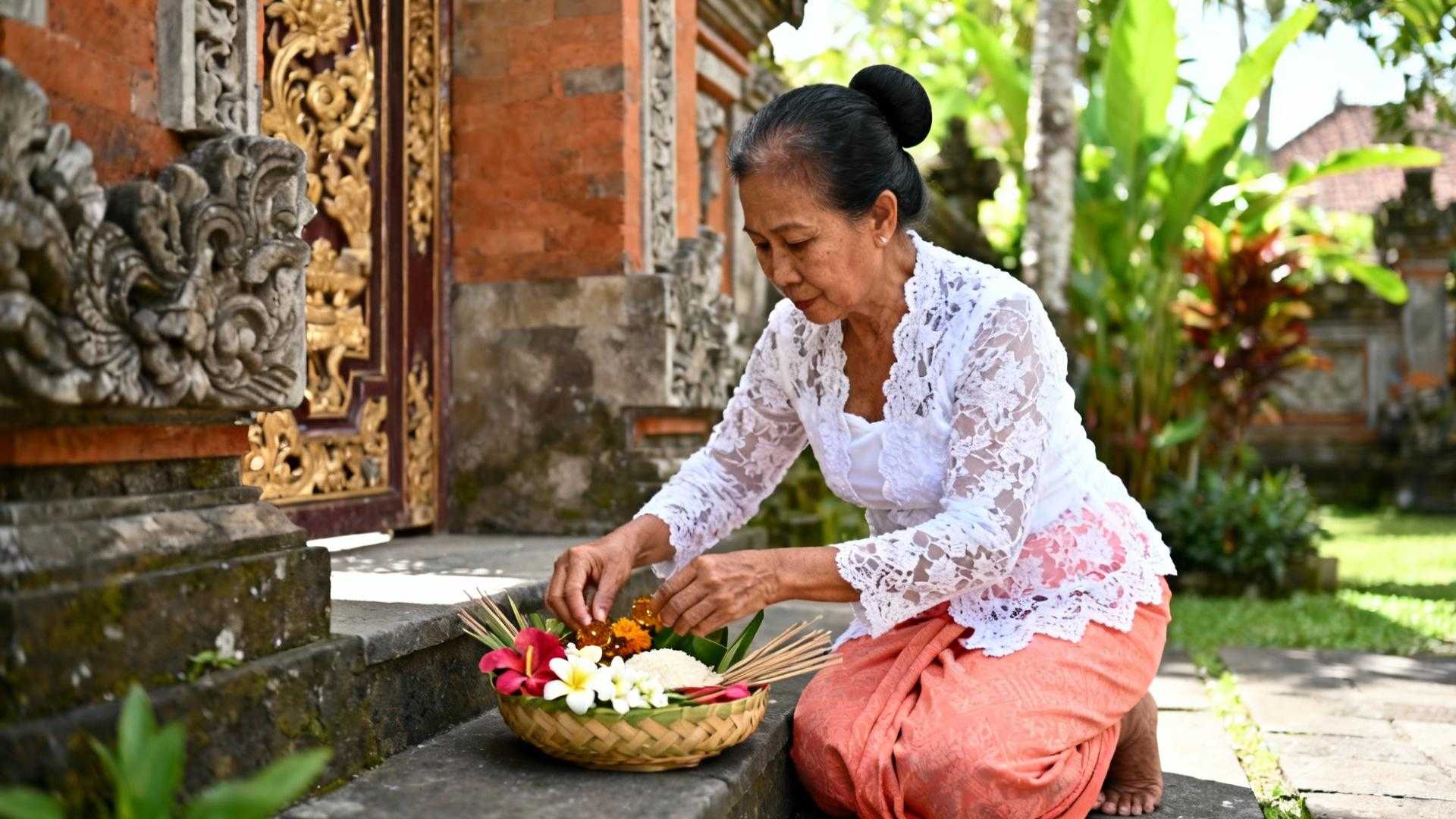At 5:30 AM, while tourists sleep off their Canggu beach parties, 68-year-old Kadek arranges her thirteenth canang sari offering of the day. Small woven baskets filled with rice, flowers, and incense appear at her doorstep, shop entrance, and family shrine. She moves with practiced silence through rituals that 4.3 million Balinese perform daily while 16 million annual visitors mistake these sacred offerings for quaint decorations.
The Sacred Codes Tourists Never Learn
Temple entrances reveal the first cultural divide. Balinese women automatically wrap their sarongs before approaching sacred gates, adjusting fabric with unconscious precision. Tourist groups fumble with rental sarongs, often wearing them incorrectly or entering restricted areas.
Governor Koster’s 2025 regulations now impose fines ranging from $50 to $200 for temple dress violations. Menstruating women and tourists without traditional attire cannot enter utamaning mandala and madyaning mandala, the most sacred temple zones. Locals learned these protocols in childhood, while visitors discover them through expensive mistakes.
The penalty system reflects growing frustration. Sacred site disrespect now carries fines up to $500, yet Seoul’s dawn rituals that 10 million locals practice while tourists sleep demonstrate similar cultural protection patterns across Asia.
Morning Rhythms Tourists Sleep Through
Before sunrise, Balinese households begin canang sari preparation. These daily offerings require specific flowers, rice arrangements, and placement timing that varies by lunar calendar. Tourism brochures promote sunrise yoga sessions at the exact moments locals perform their most sacred rituals.
The 5am devotion practice invisible to resort guests
Traditional families create between 11 and 15 offerings daily, each requiring 10 minutes of careful assembly. Materials cost approximately 15,000 Indonesian rupiah ($1) per household daily. The practice represents devotion, not decoration, yet tourists photograph offerings without understanding their spiritual significance.
Why locals avoid Western wellness tourism spots
Mount Batur’s sunrise viewpoints attract hundreds of international visitors seeking Instagram moments. Local Hindus prefer family temple ceremonies during these same dawn hours. The contrast highlights different approaches to spirituality versus tourism consumption.
Transportation Etiquette That Defines Insider Status
Motorbike behavior immediately identifies locals versus tourists. Balinese riders slow respectfully during religious processions, understanding when roads become sacred spaces. Tourist riders often honk impatiently, unaware they’re disrupting temple ceremonies.
The unwritten traffic rules during religious events
Galungan and Kuningan festivals transform ordinary streets into procession routes. Locals automatically yield right-of-way to ceremonial participants carrying sacred objects. Tourist violations now incur penalties up to $300 for reckless driving, including riding without helmets or proper licenses.
The 2025 regulations prohibit tourists from renting loud motorcycles, addressing noise pollution complaints from temple communities. Just as the unspoken rules Tel Avivians desperately want tourists to learn protect local quality of life.
Parking protocols at sacred sites
Temple parking follows invisible hierarchies. Locals park motorcycles in designated areas, remove helmets before approaching gates, and never block ceremonial pathways. Tourist rental cars often occupy spaces reserved for religious participants, creating cultural friction.
Social Fabric Woven Through Daily Respect
Festival participation reveals the deepest cultural boundaries. Locals engage in banjar community meetings, contribute to temple maintenance costs, and participate in ngaben cremation ceremonies that bind neighborhoods together. Tourism marketing promotes festival observation but misses the participatory obligations of belonging.
Environmental practices separate insiders from visitors. Balinese families minimize single-use plastics, following traditional waste reduction methods. The 2025 regulations ban plastic bags, styrofoam, and plastic straws, enforcing practices locals maintained culturally.
Governor Koster emphasized: “Bali is a beautiful, sacred island, and we expect our guests to show the same respect that we extend to them.” His circular letter mandates tour guides brief tourists about penalties, with guides facing fines for failing to educate visitors properly. Similar cultural preservation efforts appear in what Romans actually do every Sunday while 10 million tourists miss it.
Your Questions About 9 Things Locals Do Differently in Bali That Tourists Never Notice Answered
What’s the actual cost of violating temple dress codes in 2025?
Temple dress violations now carry mandatory fines from $50 to $200, scaled by severity. Sacred site disrespect can reach $500 penalties. Proper sarong rental costs 20,000 rupiah ($1.30) at temple entrances, while traditional ceremonial attire ranges from $3 to $10 at local markets.
Can tourists participate in Galungan festival activities or just observe?
Observation is welcomed at public ceremonies, but family temple rituals remain private. Locals appreciate respectful distance more than forced participation. Community banjar meetings and temple maintenance contributions require long-term residence and cultural integration beyond typical tourist stays.
How does Bali’s cultural enforcement compare to other Southeast Asian destinations?
Bali maintains stricter Hindu temple protocols than Thailand’s tourist-adapted Buddhist sites. Menstruation restrictions, mandatory sarong requirements, and sacred zone access limitations exceed most regional destinations. The 2025 penalty system represents Southeast Asia’s most aggressive cultural tourism regulation, similar to protective measures found in Montreal food rituals locals guard from 4.3 million tourists.
At Tirta Empul Temple, holy springs flow through channels carved 1,000 years ago. A Balinese grandmother enters the purification pools wearing white kebaya, her movements deliberate and reverent. Tour groups photograph from restricted viewing areas, separated by cultural understanding as vast as the temple’s sacred geography.
